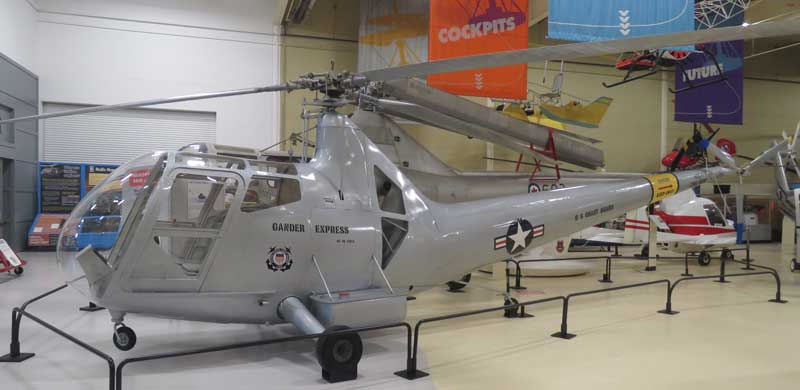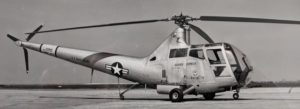
The Sikorsky R-6, while retaining the rotor and transmission system of the fabric-covered R-4, had a more powerful engine. The tail boom was all metal, and the fuselage had phenolic resin panels reinforced by fiberglass, a significant technology advance at the time. All these features led to increased performance of the R-6 over the R-4.
Sikorsky built 27 experimental aircraft in late 1943 while Nash Kelvinator (better remembered for automobiles and domestic appliances) built all 193 production R-6A models under license. The Navy acquired 36 R-6As which were then designated HOS-1s. The Coast Guard purchased 27 of these in 1945-46.
Some of the Coast Guard HOS-1s were devoted to development of new types of search and rescue equipment and techniques, including hover stabilizers, rescue hoists, and external fuel tanks. Some fuselage modifications allowed stowage of a stretcher transversally behind the pilot.
The HOS-1, acquired and restored by AHMEC, was designated Gander Express following the 1946 rescue of injured passengers from a crashed Sabena Airlines DC-4 airliner in Gander, Newfoundland, by a Coast Guard HNS-1 (R-4) and the HOS-1 (R-6).
Is AHMEC’s HOS-1 the original Gander Express? We cannot be sure the entire aircraft is. While the log book and paper trail indicate that it is, the aircraft was received in parts and two major pieces (the fuselage and the tail boom) did not perfectly align, suggesting those parts are from two aircraft.
| Aircraft Specifications | |
|---|---|
| Crew/Passengers | 3 |
| Rotor Diameter | 38 ft |
| Length | 48 ft |
| Maximum Speed | 96 mph |
| Cruise Speed | 90 mph |
| Empty Weight | 2,232 lbs |
| Gross Weight | 3,242 lbs |
| Range | 245 miles |
| Service Ceiling | 10,200 ft |
| Engine | One 236 hp Franklin 0-405-9 |
| Cost | $59,450 |
| Acquisition Source | Peter Wright donation |
Restoration by AHMEC volunteers
Object No: 300, S/N 45-45531, CG No 75610
